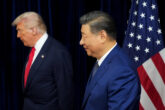June 29, 2018
Should the U.S. Start a Trade War with China over Tech?
A ChinaFile Conversation
Just as China pursues asymmetric strategies in the military domain, using cheaper missiles and mines to offset expensive American carriers and bases, so too is it pursuing asymmetric approaches in the economic domain. Chinese technology theft and transfer – through cyber-espionage, forced technology sharing, state-backed purchases of Western companies, and the repatriation of researchers – constitute a longstanding, documented, and asymmetric shortcut to the technological frontier relative to laborious and costly American investments in research and innovation.
As China gains ground in a technological race with the United States, many argue that the United States should “run faster” by recommitting to basic science research, high-skilled immigration, and funding for STEM research. These are necessary prescriptions, and they are increasingly important as China itself becomes a leading innovator, but they are insufficient to cope with China’s technological challenge. Running faster will do little good if China takes shortcuts to the finish line; pouring funds into innovation will produce little economic and strategic advantage if those breakthroughs are promptly transferred to China.
The essential question for U.S. policy, then, is not simply whether and how the United States should run faster—virtually all agree that it should—but how it should recalibrate economic and technology interdependence with China without undermining its own technological dynamism.
The United States needs a “managed interdependence” with China in the technology domain, one that recognizes how essential China’s innovative ecosystem in hardware is to U.S. companies—as Matt Sheehan has shown—but also acknowledges that certain practices in technology investment, education, and supply chains need adjustment. When it comes to sensitive technologies, Washington should not treat all activities of a Party-state that blurs the public and private as if they are as benign as those of a U.S. ally.
Read the Full Article at ChinaFile
More from CNAS
-
Transatlantic Security / Technology & National Security
Look Before We Leap on Artificial IntelligenceThis article was originally published on The Dispatch. A debate about the role that artificial intelligence should and will play in society, and how it will affect humanity fo...
By Jon B. Wolfsthal
-
Technology & National Security
Caleb Withers on the Cybersecurity Frontier in the Age of AICaleb Withers, research associate at the Center for a New American Security, joins Kevin Frazier, the AI Innovation and Law Fellow at the University of Texas School of Law and...
By Caleb Withers
-
Technology & National Security
Prepared, Not ParalyzedExecutive Summary The Trump administration has embraced a pro-innovation approach to artificial intelligence (AI) policy. Its AI Action Plan, released July 2025, underscores t...
By Janet Egan, Spencer Michaels & Caleb Withers
-
Indo-Pacific Security / Technology & National Security
Sharper: Tech + ChinaRecent talks between President Donald Trump and Chinese Communist Party General Secretary Xi Jinping placed a spotlight on emerging technologies, from high-end chips to minera...
By Charles Horn & Sevi Silvia




